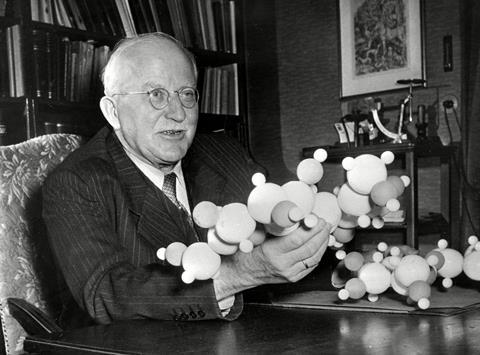Mike Sutton unravels Hermann Staudinger’s long hunt to understand macromolecules, which began 100 years ago
Beginners in chemistry soon discover that there are important differences between mixtures and chemical compounds. Adding dilute acid to a mixture of sulfur and iron generates hydrogen gas. Heating the iron–sulfur mixture first, and then treating the resulting compound with the same acid, produces a different gas with an unmistakable smell. So far, so simple – but in many cases the distinction between mixtures and compounds is harder to make.
For a long time, many naturally occurring organic substances seemed difficult to categorise. With standard laboratory solvents they tended to form cloudy suspensions, rather than clear solutions which might eventually precipitate crystals of unambiguous composition. But 100 years ago, the German chemist Hermann Staudinger boldly proposed that many of these problematic substances were genuine compounds, composed of extremely large molecules.

Most of his contemporaries disagreed, arguing that what Staudinger called ‘macromolecules’ were merely loosely linked aggregates of smaller molecules. But eventually his view prevailed, and he received the Nobel chemistry award for 1953. The very next year, polypropylene was added to the list of commercially available polymers, joining polyethylene, polystyrene and polyvinyl chloride. In 2015 alone, some quarter of a billion tonnes of these four polymers were produced.
In the century since Staudinger first presented his ideas to a sceptical audience, macromolecules and the products made from them have become a part of everyday life for everyone around the world. They remain a wonder material for some, but a worry for others.
Early life
The medieval city of Worms in Germany’s Rhineland changed hands violently in several Franco-German wars, but when Hermann Staudinger was born there in 1881, Worms was a quiet provincial town which provided a tranquil environment for his early education. Herman’s father – a high school teacher, neo-Kantian philosopher and member of Germany’s Social Democratic Party – encouraged his son’s interest in botany, but suggested that he also learned some chemistry.
After leaving school in 1899 Herman studied science at Darmstadt and Munich, before gaining his doctorate at the University of Halle in 1903 with a thesis on organic chemistry. He then worked as assistant to Johannes Thiele at Strasbourg, while continuing to pursue his own research. This led him to investigate a previously unknown family of highly reactive organic compounds – the ketenes – and to publish extensively on their chemistry.

In 1907 Staudinger was appointed professor of organic chemistry at Karlsrühe University, and in 1912, he succeeded the future Nobel laureate Richard Willstätter at Switzerland’s elite Federal Institute of Technology in Zurich. There, Herman and his wife Dorothea joined a pacifist group convened by theology professor Leonhard Ragaz. Dorothea, the daughter of an Evangelical clergyman, was a committed socialist and pacifist. The couple were married in 1906, and had four children.
When the first world war began, leading German scientists endorsed a declaration supporting their nation’s war aims. Staudinger did not join them. In 1917 he concluded (from an analysis of economic data) that Germany could not win the war, and recommended immediate peace negotiations. The German High Command responded by inviting him to return home and help create new chemical weapons that would ensure victory. Instead, he chose to continue his own research in Zurich.
An uber breakthrough
By 1917 Staudinger was turning towards a field shunned by many academic chemists. Trying to extract pure substances with definite formulae from messy animal or vegetable products was a tedious and unrewarding activity – researchers working with more cooperative materials dismissed it scornfully as ‘grease chemistry’. Nevertheless, one of these awkward substances was attracting some scrutiny.
The development of pneumatic tyres had turned rubber into an important commodity, and the motorisation of military transport made securing supplies of it – or of an acceptable alternative – a strategic priority. British and French chemists in the 19th century showed that natural rubber was a polymer of isoprene (C5H8), and a synthetic version of it was produced in Germany in 1909. During the first world war, several combatants used rubber substitutes, and research continued afterwards, driven by fears that natural sources would not meet the increasing demand.

Staudinger played little part in the industrial dimension of this activity, and patented very few of his discoveries. His chief concern was the chemical composition of these problematic polymers. In 1920 he published a ground-breaking paper – titled simply Über Polymerisation (only recently translated into English) – in which he argued that rubber (and many other natural products) were composed of molecules far larger than had previously been suspected. Shortly afterwards, he began calling them ‘makromolekülen’.
Leading European chemists, like the German Carl Harries and the Swiss Paul Karrer, had long argued that natural materials such as rubber, cellulose, and proteins consisted of aggregates of relatively small molecules, loosely linked by intermolecular forces weaker than normal valence bonds. They thought individual molecules with relative masses greater than about 5000 units must be unstable, and would disintegrate spontaneously if synthesised. Staudinger, however, argued that polymers linked only by normal chemical bonds could have molecular masses measured in millions.
Resolving this dispute was difficult, because with standard laboratory solvents these substances – even when pure – generally formed colloidal suspensions rather than solutions. And since these colloids did not conform to Raoult’s law, it was impossible to obtain reliable values for the relative masses of their component molecules by measuring freezing-point depression or boiling-point elevation. In 1920 Staudinger lacked conclusive evidence for his thesis – getting it would require much effort and ingenuity.
Vigorous critics
Defenders of the aggregate theory argued that weak intermolecular attractions – generated by the numerous double valence bonds in its constituent units – were the cause of rubber’s distinctive properties. There were precedents for this idea – Staudinger’s former mentor, Johannes Thiele, had studied organic compounds rich in double bonds and explained some of their puzzling properties by invoking ‘partial valences’. In 1922, Staudinger and his assistants tested this hypothesis by hydrogenating rubber to open up its double bonds.
The resulting ‘hydro-rubber’ retained its elastic properties, and with standard solvents it still produced colloidal suspensions, rather than solutions. Apparently, hydrogenation had not broken up the hypothetical aggregates. But his critics remained unconvinced, and Staudinger was challenged vigorously on his return to Germany in 1926.
His new appointment at the University of Freiburg was doubly controversial. For many, his wartime pacifism remained as objectionable as his ideas on macromolecules. Fritz Haber – the Nobel prize-winner who had masterminded Germany’s military deployment of poison gasses – attacked him vigorously on both fronts. Staudinger must have expected some hostility when he accepted the Freiburg chair. But he could scarcely have foreseen that the Nazi coup in 1933 would put his career, his liberty – and possibly his life – at risk.
The price of Staudinger’s survival was political silence
The move to Freiburg also marked the end of Staudinger’s first marriage. Dorothea remained in Zurich with their children, and subsequently married a communist. In 1927, Herman married Magda Voita, a Latvian biologist whose research on plant physiology (and particularly on cell wall membranes) closely paralleled his own. Magda became his life-long collaborator, and oversaw the posthumous publication of his complete works.
Let the data do the talking
To convince his critics, Staudinger sought more data about the colloidal suspensions which so many natural products formed with standard solvents. A fresh approach to them had recently emerged from studies of Brownian motion – the random buffeting of barely detectable colloidal particles by invisible solvent molecules. Calculations by Albert Einstein (then a Swiss citizen) and Polish physicist Marian Smoluchowski, when applied to observations by the French physicist Jean Perrin, now made it possible to estimate the mass of these particles .
Nevertheless, Staudinger could not yet prove that colloid particles were individual macromolecules, rather than the aggregates posited by his opponents. There were similar objections to estimates of the molecular masses of colloids calculated from osmotic pressure measurements. So, in the 1920s Staudinger’s group began synthesising their own polymers from organic molecules like styrene.
By varying the reaction conditions for a given monomer, they generated a range of products which could be ordered like a homologous series. Starting with simpler substances of known composition and upscaling to more complex ones, they established a relationship between viscosity and molecular mass, now known as the Staudinger law. They found the correlation to be a complex one, since viscosity is affected by the molecule’s geometry, as well as by its mass.
Although Staudinger’s results were much discussed at German chemistry conferences during the 1920s, they failed to convert committed defenders of the aggregation theory like the organic chemist Rudolf Pummerer. The x-ray crystallographer Herman Mark was more sympathetic to the macromolecular idea, but remained unconvinced until later x-ray observations began supporting it. In the chemical industry, however, Staudinger’s viscometry techniques were widely adopted.
Meanwhile, fresh data was generated by the ultracentrifuge, an instrument developed by Swedish physical chemist Theodor Svedberg when he was a visiting professor at the University of Wisconsin in the US in 1923. Soon after returning to Sweden, Svedberg showed that subjecting colloids to a centrifugal force many thousands of times greater than the earth’s gravitational pull could accelerate the sedimentation of their particles. This enabled him to isolate pure substances, and – by comparing rates of sedimentation – to estimate their molecular masses.
In 1924 Svedberg found the relative mass of the haemoglobin molecule to be approximately 68,000 units, and in 1928 he put the molecular mass of haemocyanin (the blood pigment of the snail helix pomatia) at about 5 million. Although his results supported Staudinger’s theory, Svedberg did not point this out in his publications. Naturally, Staudinger was keen to acquire his own ultracentrifuge, but he could not raise the necessary funds.
Industry takes notice
Meanwhile, chemical research in the US was being generously supported by industry. The DuPont chemical company had an innovative laboratory, and in 1928 a young American chemist, Wallace Carothers, left a teaching post at Harvard University to work there on polymers. He found Staudinger’s theories attractive, even though the evidence for them remained inconclusive. At DuPont, however, Carothers focussed on polymerisations driven by condensation reactions, and by measuring the quantity of water they generated he estimated the size of the resulting macromolecules. Sadly, Carothers suffered from a depressive illness, and in 1937, aged 41, he took his own life.
Carothers’ investigations led to the synthesis of nylon – a lucrative product for DuPont – as well as providing fresh support for the macromolecular concept. But following the Nazi coup in 1933, Staudinger faced opponents more aggressive than his academic critics. He was arrested by the Gestapo, interrogated at length, and forced to sign an undated letter of resignation. After further investigation he was permitted to remain in post, but kept under surveillance and forbidden to travel abroad.

While Hermann Staudinger’s position would remain precarious until 1945, his younger brother was in immediate danger. Hans Staudinger had been a Social Democrat member of the Reichstag, and his wife Else was of Jewish ancestry. The couple escaped from Germany via Belgium, and were settled in New York by 1934. Hermann remained in Freiburg with Magda, and they continued studying biologically important macromolecules until Allied bombing wrecked their laboratory in 1944. The price of Staudinger’s survival was political silence, but he did manage to protect some Jewish colleagues from dismissal by certifying that their work was essential to the war effort.
Following the Allied victory in 1945, Staudinger worked to rebuild and rehabilitate German science. In 1947 he founded the influential journal Makromoleculare Chemie (now Macromolecular Chemistry and Physics) and after retiring from his university post in 1951 he headed a new institute for macromolecular research, directly funded by the state. When presenting him with the 1953 Nobel chemistry award, Arne Fredga observed ‘It is no secret that for a long time many colleagues rejected your views… Perhaps this was understandable. In the world of polymers, almost everything was new and untested. Long standing established concepts had to be revised or new ones created.’
The creation and eventual validation of a new concept, rather than any single experimental breakthrough, was Staudinger’s major achievement. Since his death in 1965, science, medicine and technology have been massively impacted by our growing understanding of the macromolecular realm. The durability of modern polymers has made life-saving implantable devices like heart pacemakers practicable, but it also causes massive pollution in the world’s oceans. Thanks to Staudinger’s legacy, we all benefit from the improvements that plastics can offer, but sadly, we are only just beginning to take full responsibility for their potential downsides.
Mike Sutton is a science historian based in Newcastle, UK













No comments yet